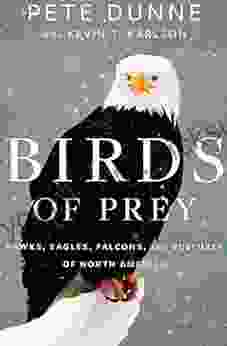The Majestic Raptors of North America: Hawks, Eagles, Falcons, and Vultures

North America is home to a diverse array of raptors – birds of prey that dominate the skies with their keen eyesight, powerful talons, and specialized hunting techniques. Hawks, eagles, falcons, and vultures are the most prominent members of this avian elite, each group possessing unique characteristics and ecological roles. Join us on an enthralling journey as we explore the fascinating world of North America's majestic raptors.
4.7 out of 5
| Language | : | English |
| File size | : | 90217 KB |
| Text-to-Speech | : | Enabled |
| Enhanced typesetting | : | Enabled |
| Print length | : | 317 pages |
| Lending | : | Enabled |
| Screen Reader | : | Supported |
Hawks
General Characteristics
Hawks are a diverse group of medium-sized raptors known for their broad, rounded wings that allow for agile maneuvers. They typically have sharp, hooked beaks and powerful talons for capturing and holding prey. Their keen eyesight enables them to spot potential targets from great distances.
Habitat and Distribution
Hawks inhabit a wide range of habitats, from forests and grasslands to wetlands and mountainous areas. They are found throughout North America, from Alaska to Mexico. Some species are migratory, while others are resident year-round.
Hunting Strategies
Hawks employ a variety of hunting techniques, depending on the species and prey availability. They often perch on high vantage points, scanning their surroundings for potential prey. When a target is spotted, the hawk swoops down with incredible speed and precision, using its talons to capture its meal.
Notable Species
- Red-tailed Hawk: This common hawk is easily recognizable by its distinctive reddish-brown tail. It is a versatile predator that hunts a wide range of animals, from rodents to rabbits.
- Cooper's Hawk: A smaller but equally skilled hunter, the Cooper's Hawk specializes in capturing birds. It has a distinctive gray plumage and a long, rounded tail.
- Broad-winged Hawk: This hawk is known for its broad, soaring wings that allow it to cover large distances while searching for prey. It primarily hunts small mammals and reptiles.
Eagles
General Characteristics
Eagles are the largest and most powerful raptors in North America. They are characterized by their massive size, heavy beaks, and piercing eyesight. Their wings are long and broad, enabling them to soar effortlessly for extended periods.
Habitat and Distribution
Eagles inhabit diverse environments, including forests, open grasslands, and coastal areas. They are found throughout much of North America, except for the extreme north. Some species, like the Bald Eagle, are migratory, while others, like the Golden Eagle, are resident year-round.
Hunting Strategies
Eagles are formidable predators known for their strength and agility. They typically hunt larger prey, such as fish, rabbits, and even small deer. They use their powerful beaks to tear apart their prey and their sharp talons to crush bones.
Notable Species
- Bald Eagle: The national bird of the United States, the Bald Eagle is a majestic symbol of strength and freedom. It is known for its distinctive white head and tail feathers.
- Golden Eagle: A formidable predator, the Golden Eagle is the largest eagle in North America. It has exceptional eyesight and can spot prey from miles away.
- Steller's Sea Eagle: This massive eagle is found along the Pacific coast of North America. It primarily hunts fish and is known for its distinctive white tail and dark plumage.
Falcons
General Characteristics
Falcons are unique among raptors due to their sleek, streamlined bodies and pointed wings. They are incredibly fast and agile, capable of reaching speeds of over 200 miles per hour during dives. Falcons have sharp, hooked beaks and long, slender talons for capturing their prey.
Habitat and Distribution
Falcons are found in a variety of habitats, including grasslands, forests, and open areas. They are distributed throughout North America, with some species migratory and others resident year-round.
Hunting Strategies
Falcons are specialized hunters designed for speed and accuracy. They typically hunt birds in mid-air, using their incredible speed and agility to outmaneuver their prey. Falcons also use their sharp talons to strike their prey with pinpoint precision.
Notable Species
- Peregrine Falcon: This is the fastest animal on the planet, reaching speeds of over 200 miles per hour during dives. It primarily hunts birds and is known for its distinctively dark back and pale underside.
- American Kestrel: The smallest falcon in North America, the American Kestrel is a common sight in open areas and grasslands. It feeds primarily on insects and small rodents.
- Merlin: This small but powerful falcon is known for its aggressive hunting style and agility. It is a specialist in capturing small birds and rodents.
Vultures
General Characteristics
Vultures are a unique group of raptors that primarily feed on carrion – the dead remains of animals. They play an essential role in the ecosystem by cleaning up carcasses and preventing the spread of disease. Vultures have keen eyesight and a specialized sense of smell that help them locate food sources from great distances.
Habitat and Distribution
Vultures are found in a variety of habitats, including prairies, savannahs, and forests. They are distributed throughout the Americas, with some species migratory and others resident year-round.
Hunting Strategies
Vultures do not actively hunt live prey. Instead, they rely on their keen eyesight and sense of smell to locate carcasses. Vultures often soar high in the sky, scanning the landscape for signs of death. Once a carcass is located, vultures descend in numbers to feed.
Notable Species
- Turkey Vulture: This widespread vulture is commonly seen gliding over open areas and along roadsides. It has a red head and a dark, featherless neck.
- Black Vulture: Smaller than the Turkey Vulture, the Black Vulture is known for its black plumage and gray head. It is often found near human settlements.
- California Condor: The largest flying bird in North America, the California Condor is an endangered species. It has a massive wingspan and a distinctive black and white plumage.
Ecological Roles
Hawks, eagles, falcons, and vultures play crucial ecological roles in North America. They help regulate small mammal populations, control pests, and clean up carcasses, preventing the spread of disease. By maintaining the balance of nature, these majestic raptors contribute to the overall health and stability of the ecosystems they inhabit.
Conservation
Many raptor species are facing threats due to habitat loss, illegal hunting, and the use of pesticides. Conservation efforts are essential to protect these magnificent birds and ensure their survival for generations to come. By creating protected areas, reducing habitat destruction, and protecting against threats, we can safeguard the future of North America's majestic raptors.
North America's raptors – hawks, eagles, falcons, and vultures – are a testament to the extraordinary diversity and beauty of the natural world. Their specialized hunting techniques, ecological roles, and awe-inspiring presence in the skies captivate the imagination and inspire wonder. By appreciating and conserving these majestic birds, we not only ensure their survival but also safeguard the balance and health of our ecosystems for generations to come.
4.7 out of 5
| Language | : | English |
| File size | : | 90217 KB |
| Text-to-Speech | : | Enabled |
| Enhanced typesetting | : | Enabled |
| Print length | : | 317 pages |
| Lending | : | Enabled |
| Screen Reader | : | Supported |
Do you want to contribute by writing guest posts on this blog?
Please contact us and send us a resume of previous articles that you have written.
 Fiction
Fiction Non Fiction
Non Fiction Romance
Romance Mystery
Mystery Thriller
Thriller SciFi
SciFi Fantasy
Fantasy Horror
Horror Biography
Biography Selfhelp
Selfhelp Business
Business History
History Classics
Classics Poetry
Poetry Childrens
Childrens Young Adult
Young Adult Educational
Educational Cooking
Cooking Travel
Travel Lifestyle
Lifestyle Spirituality
Spirituality Health
Health Fitness
Fitness Technology
Technology Science
Science Arts
Arts Crafts
Crafts DIY
DIY Gardening
Gardening Petcare
Petcare Stefan Hunziker
Stefan Hunziker Andy Crowe
Andy Crowe Robert E Stake
Robert E Stake Mike Chambers
Mike Chambers Jeff Mach
Jeff Mach Tom Chatfield
Tom Chatfield Ariel Henley
Ariel Henley Roland A Boucher
Roland A Boucher Samir P Desai
Samir P Desai Rob Willson
Rob Willson Cynthia Nims
Cynthia Nims Mark Rosenman
Mark Rosenman Michael Anthony
Michael Anthony Michael Driscoll
Michael Driscoll Jodi Shabazz
Jodi Shabazz Liv Ryan
Liv Ryan Alberta Hawse
Alberta Hawse Judith Hoare
Judith Hoare Alessio Mangoni
Alessio Mangoni Viviana Altuve
Viviana Altuve Tom Dymond
Tom Dymond J D Swanson
J D Swanson Robert Urban
Robert Urban Rachel Kowert
Rachel Kowert Kim Foley Mackinnon
Kim Foley Mackinnon Robyn Ryle
Robyn Ryle David Kinney
David Kinney Peter Townsend
Peter Townsend Chris Santella
Chris Santella Emily Nielson
Emily Nielson Howell Raines
Howell Raines Mark Remy
Mark Remy L S Boos
L S Boos Thomas Gilovich
Thomas Gilovich Jason Hogan
Jason Hogan Meg Long
Meg Long Mark Kernion
Mark Kernion Richard G Brown
Richard G Brown Mark W Steege
Mark W Steege Neil Hawkesford
Neil Hawkesford Miranda Green
Miranda Green John B Nici
John B Nici John Samuel Barnett
John Samuel Barnett Johnny Molloy
Johnny Molloy Catherine Mccord
Catherine Mccord Rebecca Eanes
Rebecca Eanes Mark Synnott
Mark Synnott Stephen Jungmann
Stephen Jungmann Kyle Graves
Kyle Graves Keith Elliot Greenberg
Keith Elliot Greenberg Arlin Smith
Arlin Smith Tim Macwelch
Tim Macwelch Laura Bogen
Laura Bogen Nicholas Epley
Nicholas Epley Andy Puddicombe
Andy Puddicombe Bill Schneider
Bill Schneider Cory Mortensen
Cory Mortensen Chris Chelios
Chris Chelios Tanya Lee Stone
Tanya Lee Stone Danil Zburivsky
Danil Zburivsky William Ayers
William Ayers Joel J Lerner
Joel J Lerner Angela C Wu
Angela C Wu Dave Smith
Dave Smith Ken Dryden
Ken Dryden Linda Sivertsen
Linda Sivertsen Carlo Rovelli
Carlo Rovelli Stephen Grossberg
Stephen Grossberg Andy Schell
Andy Schell Mark Lester
Mark Lester Jules Brown
Jules Brown Miles Olson
Miles Olson William D Lopez
William D Lopez Jeff Fleischer
Jeff Fleischer Emma Dalton
Emma Dalton Michael V Uschan
Michael V Uschan Laura Hillman
Laura Hillman Teresa Parker
Teresa Parker Stephen Cheney
Stephen Cheney George Noory
George Noory Robb Manning
Robb Manning Oliver Burkeman
Oliver Burkeman Kate Le Roux
Kate Le Roux Emily Souder
Emily Souder Joy Williams
Joy Williams Rebecca Boggs Roberts
Rebecca Boggs Roberts Nicholas Jubber
Nicholas Jubber Jim Saccomano
Jim Saccomano Florian Freistetter
Florian Freistetter Tigran Bagdasaryan
Tigran Bagdasaryan Tim Thayne
Tim Thayne M J Fievre
M J Fievre Israelin Shockness
Israelin Shockness Kristina Statler
Kristina Statler Daddilife Books
Daddilife Books Cap N Fatty Goodlander
Cap N Fatty Goodlander Tania N Shah
Tania N Shah Sandy Tolan
Sandy Tolan Angela Eckhoff
Angela Eckhoff Paul Cobley
Paul Cobley Charlotte Klaar Phd
Charlotte Klaar Phd Caryl Say
Caryl Say Keylee C Hargis
Keylee C Hargis Kelly Corrigan
Kelly Corrigan Madeleine Roux
Madeleine Roux Ashley Rickards
Ashley Rickards Johnson Egonmwan
Johnson Egonmwan Tea Rozman Clark
Tea Rozman Clark Ryan D Agostino
Ryan D Agostino Rick Vaive
Rick Vaive Robin Ray Green
Robin Ray Green Margaret Jordan Halter
Margaret Jordan Halter Bob Gordon
Bob Gordon Jessica Nordell
Jessica Nordell Elizabeth Kaledin
Elizabeth Kaledin Diana Winston
Diana Winston Serena B Miller
Serena B Miller Guy Evans
Guy Evans Kathy Freston
Kathy Freston Jenny Smith
Jenny Smith Andy Mitchell
Andy Mitchell Petros Efthymiou
Petros Efthymiou Ben Ehrenreich
Ben Ehrenreich Ed Stafford
Ed Stafford Angeline Boulley
Angeline Boulley Lynn Palm
Lynn Palm Violet White
Violet White Lin Wellford
Lin Wellford Tim O Connor
Tim O Connor Bret A Moore
Bret A Moore Mercedes Pollmeier
Mercedes Pollmeier Fredrik Backman
Fredrik Backman Chip Heath
Chip Heath Germano Dalcielo
Germano Dalcielo Forrest Maready
Forrest Maready Ryan Beck
Ryan Beck Derek M Steinbacher
Derek M Steinbacher Daniel Friedmann
Daniel Friedmann Manik Joshi
Manik Joshi Richard L Sites
Richard L Sites Donald N Yates
Donald N Yates Ingrid S Clay
Ingrid S Clay Rawdon Wyatt
Rawdon Wyatt Shalabh Aggarwal
Shalabh Aggarwal Thais Nye Derich
Thais Nye Derich Jennifer Bohnet
Jennifer Bohnet William E Hearn
William E Hearn Frank Deford
Frank Deford Mometrix
Mometrix Capn Fatty Goodlander
Capn Fatty Goodlander Rachel Connelly
Rachel Connelly Robert Zubek
Robert Zubek Andy Peloquin
Andy Peloquin Massimo Florio
Massimo Florio Carlos Acevedo
Carlos Acevedo Tiara Mcclure
Tiara Mcclure Third Edition Kindle Edition
Third Edition Kindle Edition Christopher Nyerges
Christopher Nyerges Kathryn Miles
Kathryn Miles Tim Larkin
Tim Larkin Chef Maggie Chow
Chef Maggie Chow Dave Gray
Dave Gray Elly Molina
Elly Molina Jerry Toner
Jerry Toner Joseph Mazur
Joseph Mazur Mtg Editorial Board
Mtg Editorial Board Neveen Musa
Neveen Musa G K Derosa
G K Derosa Karen Elliott House
Karen Elliott House Gillian Price
Gillian Price Lucy Postgate
Lucy Postgate Marie Brennan
Marie Brennan Chanel Craft Tanner
Chanel Craft Tanner Scott Meyer
Scott Meyer Wendy Rosenoff
Wendy Rosenoff Angelina J Steffort
Angelina J Steffort Ron Jeffries
Ron Jeffries K Moriyasu
K Moriyasu Hourly History
Hourly History Lois A Ritter
Lois A Ritter Marie Myung Ok Lee
Marie Myung Ok Lee Leonard Lueras
Leonard Lueras Bernd Heinrich
Bernd Heinrich Rachel Hutt Phd
Rachel Hutt Phd James M Johnston
James M Johnston Richard Bate
Richard Bate Jamie Kuykendall
Jamie Kuykendall Cheryl Alkon
Cheryl Alkon Christian Wiggins
Christian Wiggins Robin Benway
Robin Benway Stefanie K Johnson
Stefanie K Johnson Susan Burton
Susan Burton Howard Davis
Howard Davis Rebecca Serle
Rebecca Serle Tirzah Price
Tirzah Price Walter Beede
Walter Beede Peter Finch
Peter Finch Peter Gibson
Peter Gibson Ryan Bow
Ryan Bow Angelo Lowery
Angelo Lowery R E Burrillo
R E Burrillo Dan Ariely
Dan Ariely Jenna Helwig
Jenna Helwig Bob Clouser
Bob Clouser Beth A Leonard
Beth A Leonard D M Davis
D M Davis Mark J Musser
Mark J Musser Madison Lee
Madison Lee Jay Griffiths
Jay Griffiths Ray Walker
Ray Walker Kim Dragoner
Kim Dragoner Louis Martin
Louis Martin Eugene P Northrop
Eugene P Northrop Leanne Ely
Leanne Ely Mark Verstegen
Mark Verstegen Joe Berardi
Joe Berardi Bradley T Erford
Bradley T Erford Christina Hillsberg
Christina Hillsberg Kristen S Kurland
Kristen S Kurland Jodi Picoult
Jodi Picoult Siena Cherson Siegel
Siena Cherson Siegel Rodney Castleden
Rodney Castleden Rebecca Solnit
Rebecca Solnit Andy Tyson
Andy Tyson Baby Professor
Baby Professor Hajime Isayama
Hajime Isayama Jorge Ramos Mizael
Jorge Ramos Mizael Jane M Healy
Jane M Healy Colby Coombs
Colby Coombs Mark Wells
Mark Wells Caspar Melville
Caspar Melville Angel Millar
Angel Millar Robyn Harding
Robyn Harding Christopher O Kennon
Christopher O Kennon Patrick Pickens
Patrick Pickens Erich Fromm
Erich Fromm Marilyn Burgos
Marilyn Burgos Robert Kirk
Robert Kirk Tovar Cerulli
Tovar Cerulli Eli Wilson
Eli Wilson Ben Bleiweiss
Ben Bleiweiss Seth Lloyd
Seth Lloyd Keith Crowley
Keith Crowley Lee Cronk
Lee Cronk Alex Wolf
Alex Wolf Warren Sande
Warren Sande Nicole Smith
Nicole Smith Lisa Marie Mercer
Lisa Marie Mercer T L Payne
T L Payne Joan Jacobs Brumberg
Joan Jacobs Brumberg Stuart Lawrence
Stuart Lawrence Jeffrey T Richelson
Jeffrey T Richelson Tj Faultz
Tj Faultz Pete Sampras
Pete Sampras Karl Beecher
Karl Beecher Dawn Griffiths
Dawn Griffiths Richard A Muller
Richard A Muller Scott Alan Johnston
Scott Alan Johnston Angel Burns
Angel Burns Dwight E Neuenschwander
Dwight E Neuenschwander Jay Matthews
Jay Matthews Kat Anderson
Kat Anderson Dean Beaumont
Dean Beaumont T R Fehrenbach
T R Fehrenbach Angelo Tropea
Angelo Tropea Nikki Ace
Nikki Ace Elizabeth Foss
Elizabeth Foss Samuel B Green
Samuel B Green Sylvester Nemes
Sylvester Nemes William Bryant Logan
William Bryant Logan Lawrence Goldstone
Lawrence Goldstone Eric Schmitz
Eric Schmitz Jeffrey Bernstein
Jeffrey Bernstein Cate Tiernan
Cate Tiernan Raynor Winn
Raynor Winn David Goodman
David Goodman Kim West
Kim West Marc Charles
Marc Charles Jordan Summers
Jordan Summers Christina Reese
Christina Reese Joyce Yang
Joyce Yang Jim Prime
Jim Prime Matt Vincent
Matt Vincent Emiko Jean
Emiko Jean Harold S Koplewicz
Harold S Koplewicz Julia Reed
Julia Reed Ellen Frank
Ellen Frank Angela Smith
Angela Smith Jonathan Gottschall
Jonathan Gottschall S L Macgregor Mathers
S L Macgregor Mathers Andy Jurinko
Andy Jurinko Bradley Charbonneau
Bradley Charbonneau Angela Stancar Johnson
Angela Stancar Johnson Troy A Hill
Troy A Hill Michele Borba
Michele Borba Otto Rahn
Otto Rahn Charney Herst
Charney Herst Harry Fairhead
Harry Fairhead Stacy Mccullough
Stacy Mccullough Janet Menzies
Janet Menzies Chuck Weikert
Chuck Weikert Rodney Paul
Rodney Paul Karen Sternheimer
Karen Sternheimer Rosie Daley
Rosie Daley Angelo Chiari
Angelo Chiari Martin Volken
Martin Volken Dave Duncan
Dave Duncan Katrina Cope
Katrina Cope John Sonmez
John Sonmez Diana Nyad
Diana Nyad Brian Cain
Brian Cain David C Keehn
David C Keehn Kenneth R Ginsburg
Kenneth R Ginsburg Mark Shepherd
Mark Shepherd Adam Skolnick
Adam Skolnick Tina Nelson
Tina Nelson Tom Allen
Tom Allen Muako Maepa
Muako Maepa Shane O Mara
Shane O Mara Pete Dunne
Pete Dunne Dhonielle Clayton
Dhonielle Clayton Kevin Hunter
Kevin Hunter Ron Douglas
Ron Douglas Connie Schultz
Connie Schultz Richard Hibshman
Richard Hibshman Jenna Blough
Jenna Blough United States Government Us Army
United States Government Us Army Richard Lemaster
Richard Lemaster Shreya Ramachandran
Shreya Ramachandran Dr Eva Beaulieu
Dr Eva Beaulieu Jessica Jung
Jessica Jung Patrick Ejeke
Patrick Ejeke Stephen Lynch
Stephen Lynch Nathaniel Rich
Nathaniel Rich Bob Swope
Bob Swope Tim Hannigan
Tim Hannigan Richard Lee Byers
Richard Lee Byers Jeffrey Thurston
Jeffrey Thurston Andrea Lankford
Andrea Lankford Christian Heath
Christian Heath Joe Peta
Joe Peta Irene Gut Opdyke
Irene Gut Opdyke James Quinn
James Quinn David Herres
David Herres Murtaza Haider
Murtaza Haider Jeffrey Lee
Jeffrey Lee Belinda Norton
Belinda Norton Jessica Wolstenholm
Jessica Wolstenholm Donna Mott
Donna Mott W Todd Woodard
W Todd Woodard Tovah Feldshuh
Tovah Feldshuh Mirabai Starr
Mirabai Starr Patrick M Lencioni
Patrick M Lencioni Rebecca P Cohen
Rebecca P Cohen Anna Rashbrook
Anna Rashbrook Yvonne Choquet Bruhat
Yvonne Choquet Bruhat Lidia Bastianich
Lidia Bastianich Sam Bleakley
Sam Bleakley Schoolhouse Heaven
Schoolhouse Heaven Dennis Rainey
Dennis Rainey Latonya J Trotter
Latonya J Trotter Nicholas D Kristof
Nicholas D Kristof Jonah Lehrer
Jonah Lehrer Warren St John
Warren St John Aaron Wilson
Aaron Wilson Rashaun Johnson
Rashaun Johnson Rod Powers
Rod Powers Joshua Clark
Joshua Clark Mary Pipher
Mary Pipher Stewart Shapiro
Stewart Shapiro Robert Dudley
Robert Dudley Gregory J Davenport
Gregory J Davenport Thomas Golf
Thomas Golf David E Jones
David E Jones Deborah Wall
Deborah Wall Sir Edmund Hillary
Sir Edmund Hillary Natalie Rhodes
Natalie Rhodes Judith S Beck
Judith S Beck John C Maxwell
John C Maxwell Margaret Visser
Margaret Visser Stephanie Land
Stephanie Land Phil Burt
Phil Burt Ruby Lang
Ruby Lang Andy Farrell
Andy Farrell Sam Fury
Sam Fury David Graeber
David Graeber Nick Bradley
Nick Bradley Robin Yocum
Robin Yocum Scott Turner
Scott Turner Humberto G Garcia
Humberto G Garcia Kevin J Gaston
Kevin J Gaston Sabbithry Persad Mba
Sabbithry Persad Mba Kathy Hoopmann
Kathy Hoopmann Wynne Foster
Wynne Foster Sandra Steingraber
Sandra Steingraber John Geiger
John Geiger Ted Sandling
Ted Sandling Gary B Meisner
Gary B Meisner Milton Roth
Milton Roth Margaret M Quinlan
Margaret M Quinlan Ashley P Martin
Ashley P Martin Afra J Zomorodian
Afra J Zomorodian Shenila Khoja Moolji
Shenila Khoja Moolji Judea Pearl
Judea Pearl Eliot Schrefer
Eliot Schrefer Erin Moulton
Erin Moulton Lindsay Ford
Lindsay Ford Lynn Lyons
Lynn Lyons Michael Tomasello
Michael Tomasello Tara Sim
Tara Sim Kevin Thomas
Kevin Thomas Joseph Phillips
Joseph Phillips George Megre
George Megre Mitch Horowitz
Mitch Horowitz Elizabeth Hunter
Elizabeth Hunter Lutz Hanseroth
Lutz Hanseroth Scott Stillman
Scott Stillman Matthew D Dewar
Matthew D Dewar Kent David Kelly
Kent David Kelly Jeremy Klaff
Jeremy Klaff Jon Ronson
Jon Ronson Lisa Preston
Lisa Preston Tristan Higbee
Tristan Higbee Sharon Strand Ellison
Sharon Strand Ellison Andy Dowsett
Andy Dowsett Mandee Heller Adler
Mandee Heller Adler Ellen J Langer
Ellen J Langer Donna Helen Crisp Jd Msn Rn Pmhcns Bc
Donna Helen Crisp Jd Msn Rn Pmhcns Bc Karl E Peace
Karl E Peace Avinash Navlani
Avinash Navlani Frederick Aardema
Frederick Aardema Jeanne Godfrey
Jeanne Godfrey Douglas Henderson Jr
Douglas Henderson Jr Greg Prato
Greg Prato Steve Hindman
Steve Hindman Carol Ann Gillespie
Carol Ann Gillespie Yuu Tanaka
Yuu Tanaka Angela Thayer
Angela Thayer Jim Posewitz
Jim Posewitz George E Hein
George E Hein Ben Campbell
Ben Campbell Barak Ariel
Barak Ariel Roger Craig
Roger Craig Rufus Estes
Rufus Estes Robyn Wideman
Robyn Wideman Kristen Jervis Cacka
Kristen Jervis Cacka Rafael Gordillo Naranjo
Rafael Gordillo Naranjo Angela Leslee
Angela Leslee Jo May
Jo May Devaki Lakshmi
Devaki Lakshmi Kari Marie Norgaard
Kari Marie Norgaard Rebecca Hemmings
Rebecca Hemmings Donald R Prothero
Donald R Prothero George Johnson
George Johnson Barry Pickthall
Barry Pickthall Wayne Mcghie
Wayne Mcghie Robert Lindsay
Robert Lindsay Ruth Benedict
Ruth Benedict Gerard Siggins
Gerard Siggins Dan Heath
Dan Heath Stephen Rea
Stephen Rea
Light bulbAdvertise smarter! Our strategic ad space ensures maximum exposure. Reserve your spot today!
 Ethan GrayFollow ·5.2k
Ethan GrayFollow ·5.2k Forrest BlairFollow ·15k
Forrest BlairFollow ·15k Jeffrey CoxFollow ·3.5k
Jeffrey CoxFollow ·3.5k Fyodor DostoevskyFollow ·8.9k
Fyodor DostoevskyFollow ·8.9k Ken SimmonsFollow ·11.1k
Ken SimmonsFollow ·11.1k Darnell MitchellFollow ·17.3k
Darnell MitchellFollow ·17.3k Joseph ConradFollow ·15.1k
Joseph ConradFollow ·15.1k Alan TurnerFollow ·16.2k
Alan TurnerFollow ·16.2k

 Devon Mitchell
Devon MitchellDelve into the Comprehensive World of Cartridges: A...
In the realm of firearms, cartridges stand...

 Joseph Conrad
Joseph ConradTales From The San Francisco 49ers Sideline: A Look...
The San Francisco 49ers are one of the most...

 Ervin Bell
Ervin BellArcGIS Desktop 10: A Comprehensive GIS Tutorial for...
Geographic information...

 Reed Mitchell
Reed MitchellPhysiology Pretest Self Assessment And Review 14th...
Accurately gauge your physiology knowledge and...

 Devin Ross
Devin RossLost At Sea: The Unbelievable True Story of the Jon...
In 2009, journalist Jon Ronson set out to...

 Shane Blair
Shane BlairModes of Thinking for Qualitative Data Analysis
Qualitative data analysis is a complex...
4.7 out of 5
| Language | : | English |
| File size | : | 90217 KB |
| Text-to-Speech | : | Enabled |
| Enhanced typesetting | : | Enabled |
| Print length | : | 317 pages |
| Lending | : | Enabled |
| Screen Reader | : | Supported |












